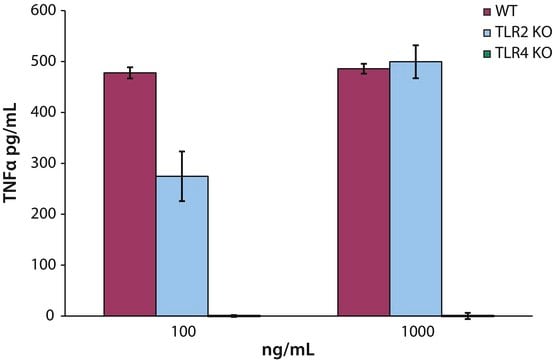L6261
Lipopolysaccharides from Salmonella enterica serotype minnesota
purified by phenol extraction
Sinónimos:
LPS
About This Item
Productos recomendados
origen biológico
Salmonella enterica (serotype minnesota)
Nivel de calidad
formulario
lyophilized powder
purificado por
phenol extraction
impurezas
<3% Protein (Lowry)
solubilidad
water: soluble
temp. de almacenamiento
2-8°C
¿Está buscando productos similares? Visita Guía de comparación de productos
Descripción general
Aplicación
- as a toll-like receptors (TLR ) agonist to induce tumor necrosis factor (TNF) α production in cereblon and Rabex-5 deficient mice in vivo,
- to study its effect on prostaglandin-E Synthase (PTGES) protein expression in monocyte-derived macrophages
- as a positive control for the maturation of monocyte-derived dendritic cells (MoDCs) to assess secretion of interleukin-10 and interferon (IFN)-γ
- as a supplement in Roswell park memorial institute (RPMI)media for culturing splenic B cells
- as a toll-like receptor 4 ligand to study its effect on the expression of the proallergic cytokines thymic stromal lymphopoietin (TSLP) and interleukin 33 (IL33) in H292 cells (pulmonary mucoepidermoid carcinoma cells)
Acciones bioquímicas o fisiológicas
Otras notas
Producto relacionado
Palabra de señalización
Danger
Frases de peligro
Consejos de prudencia
Clasificaciones de peligro
Acute Tox. 2 Oral
Código de clase de almacenamiento
6.1A - Combustible acute toxic Cat. 1 and 2 / very toxic hazardous materials
Clase de riesgo para el agua (WGK)
WGK 3
Punto de inflamabilidad (°F)
Not applicable
Punto de inflamabilidad (°C)
Not applicable
Certificados de análisis (COA)
Busque Certificados de análisis (COA) introduciendo el número de lote del producto. Los números de lote se encuentran en la etiqueta del producto después de las palabras «Lot» o «Batch»
¿Ya tiene este producto?
Encuentre la documentación para los productos que ha comprado recientemente en la Biblioteca de documentos.
Los clientes también vieron
Artículos
Explore the structure, function, and diverse applications of Lipopolysaccharides. Discover their role in bacteria, serological specificity, and research potential.
Nuestro equipo de científicos tiene experiencia en todas las áreas de investigación: Ciencias de la vida, Ciencia de los materiales, Síntesis química, Cromatografía, Analítica y muchas otras.
Póngase en contacto con el Servicio técnico




